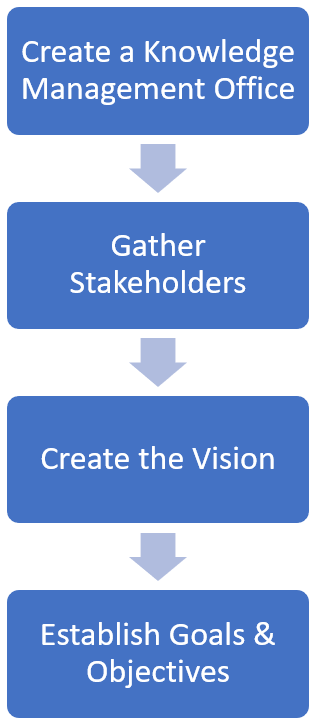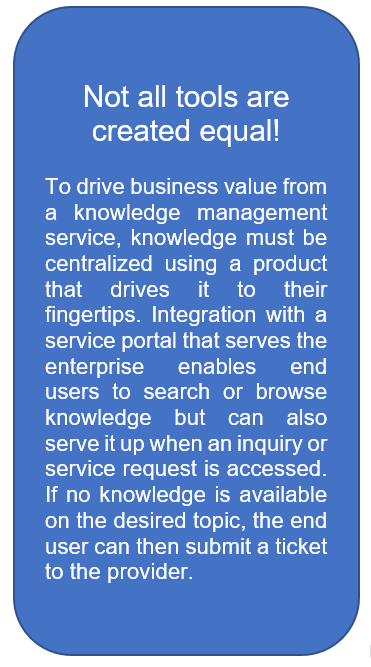Date Published May 31, 2018 - Last Updated December 13, 2018
Information. We’re flooded with it. Corporate policies, compliance training, holiday calendars, open enrollment and retirement information, technical instructions, company news…
How can an organization get a handle on the flood of information populated in shared folders, on intranet sites, and other knowledge resources and get this deluge under control?
The answer comes from developing an approach to enterprise-level knowledge management and changing the corporate culture to support it. This article will lay the foundation for creating such an approach.
Why do we have knowledge all over the place?
The answer to this question is rooted in a simple chicken-egg analogy: Which came first, the knowledge or the tool? Unfortunately, corporate groups have always sought a way to communicate policies and information for which they are accountable in any way they could. In most cases, the development of knowledge pre-dates the availability of good enterprise-wide knowledge management solutions, which is a more recent development compared to web sites, shared folders, and collaboration tools, like SharePoint. Thus, one could say the knowledge came first and tools to properly manage it came later, after point solutions were already in place.
For example, in many organizations, the question “Where are policies housed?” has a wide variety of answers from inside a policy management application to which no-one has access to shared folders or policy intranet sites. When you follow this up with an effort to define a provider’s implementation of a knowledge base, you start to see that at best you can give them a repository for some of their area-specific knowledge and allow their consumers to access common questions appropriate to the provider’s area of responsibility, unless and until the organization is ready to transform their approach to knowledge.
Enterprise Knowledge As a Service
One way to transform an organization’s knowledge approach is to get strategic about the organization’s approach, objectives, and vision of the transformation and begin thinking of knowledge management as a service, governed by a Knowledge Management Office (KMO). Starting with a top-down approach, initiated by senior executives and naming a process owner to “herd the cats” can help make this happen.
For example, a transformation initiative might have several strategic activities to get started:
 When senior management creates a Knowledge Management Office (KMO) and names a process owner, they immediately create a strategic initiative and empower the process owner to lead the effort.
When senior management creates a Knowledge Management Office (KMO) and names a process owner, they immediately create a strategic initiative and empower the process owner to lead the effort.
Identifying and appointing stakeholders representing the teams currently creating and managing knowledge within their own silos is the first step to bringing the strategy and program together. At the end of the first strategic efforts, they will continue to work together to centralize availability of knowledge, creating an enterprise knowledge practice.
Next the group must determine the vision for the organization, which would ideally be based on an enterprise-wide approach to the creation, management, and delivery of knowledge as a whole: information, policies, departmental procedures, internal information and instructions, news, etc.
Finally, understanding the vision, a handful of short-term (from 3–6 months) and long-term (from 1–3 years) goals should be established to ensure that progress and momentum remain possible over the duration of the effort. This should be backed up with a metrics program.
Once this is established, use of frameworks like Knowledge Centered Service (KCS®) can then be employed to guide the effort. A good KCS practice includes creating the strategy for knowledge management and its intended outcomes and then providing a solid operating model from which to grow. The framework combines the need for knowledge leadership and strategy to drive behavior and assist organizations in realizing the benefits of a good knowledge practice. While there is a slight lean towards IT organizations, the practice doesn’t change across provider groups. Knowledge management gives end users the opportunity to help themselves through self service. One interesting observation is that people will use self-service to find answers to 10 times more often than asking questions of a service center!
 Treating the concept of knowledge management like a business service then enables the organization to fund the service, evaluate its effectiveness and value, and then continue to manage the service as a distinct offering of the organization. The service has an owner, the KMO chair or process owner, along with a set of outcomes to achieve and an operating model (KCS based). Like any service, critical success factors and key performance indicators can be established, enabling reporting that demonstrates the achievements of the service. When the knowledge management service fails to meet objectives, a service improvement program can be initiated. Essentially, treating knowledge management as a service establishes a foundation from which to ensure its long-term success.
Treating the concept of knowledge management like a business service then enables the organization to fund the service, evaluate its effectiveness and value, and then continue to manage the service as a distinct offering of the organization. The service has an owner, the KMO chair or process owner, along with a set of outcomes to achieve and an operating model (KCS based). Like any service, critical success factors and key performance indicators can be established, enabling reporting that demonstrates the achievements of the service. When the knowledge management service fails to meet objectives, a service improvement program can be initiated. Essentially, treating knowledge management as a service establishes a foundation from which to ensure its long-term success.
Treating knowledge management like a business service enables the organization to fund the service, evaluate its effectiveness and value, and manage the service.

Key to this service’s operation, however, is the concept that all knowledge should be offered via a single portal or centralized location and that the tool used to deliver it should be capable of delivering the user experience needed to drive the value. Integration with an enterprise service management platform that supports service delivery for all the organization’s providers increases the potential of the knowledge management practice to deliver value.
In many organizations, creation of an enterprise knowledge strategy will likely follow the implementation of an enterprise service portal and request catalog. But where it does not, the first tactical effort toward centralizing knowledge may be selection of such a platform and a migration of providers into it.
While this may be the best-case scenario, organizations should not avoid moving forward with a strategic approach to enterprise knowledge management if all they have is a basic knowledge management solution or a home-grown repository. It’s still better to have all the organization’s knowledge available from a single pane of glass, even if people need to go to it solely for the purpose of information gathering. Later, if/when the organization finds itself with a single service portal and service management platform, the knowledge articles can be migrated to the new platform more easily from a central location than from a group of repositories.
From a technical standpoint, a single repository may still have several knowledge bases within it, each managed by a providers Knowledge Manager. As long as searching is consolidated and they live within the same overarching repository, it would still be considered a single pane of glass.
Benefits of a Strategic Approach
At the end of the day, without an enterprise-wide approach, knowledge will continue to grow organically within an organization, causing associates to spend a large amount of time looking for information, policies, or answers to common questions. The time spent hunting for information keeps people from being effective and contributes to low morale. Additionally, secret policies (policies that cannot be accessed by associates at will) increase that level of dissatisfaction as adoption is unlikely without training and information being available. The largest benefit of a strategically driven enterprise-wide approach may therefore be higher employee satisfaction and retention.
While implementing a knowledge practice like the one I describe here is expensive, there are several tangible benefits:
- Increased productivity due to spending less time looking for the information needed to perform an activity
- Consistent experiences when asking a provider’s group for support (for example an IT Service Desk, HR Solutions Center, or Facilities Management organization)
- Consistent service delivery by provider departments as a result of being able to locate the correct procedures
- Increased policy adoption and compliance—stricter adherence to policies may also increase the organization’s ability to pass audit and assist in securing the computing environment
- Increased satisfaction and retention
Proving the value of the knowledge management service should therefore include an ability to quantify the savings or other results, including improvements in support processing times, reduction of security incidents and improvements in system availability because of better security compliance, and reduction in audit mitigation costs etc. These measures should be established before the program begins and delivered frequently as the program is implemented and moved into ongoing operation.
Phyllis Drucker is an ITIL® certified consultant and information leader at Linium, a Ness Digital Engineering Company. Phyllis has more than 20 years of experience in the disciplines and frameworks of IT service management, as both a practitioner and consultant. She has served HDI since 1997 and itSMF USA since 2004 in a variety of capacities including speaker, writer, local group leader, board member, and operations director. Since 1997, Phyllis has helped to advance the profession of ITSM leaders and practitioners worldwide by providing her experience and insight on a wide variety of ITSM topics through presentations, whitepapers, and articles and now her new book on the service request catalog, Online Service Management: Creating a Successful Service Request Catalogue (International Best Practice). Follow Phyllis on Twitter @msitsm.